Gross-to-net Calculator
The Gross-to-Net Calculator in Tax1099 is a tool designed to help users convert gross income figures into net income. This calculation considers various deductions, taxes, and withholdings that affect take-home pay.
Navigate to the Tax1099 interface at Tax1099 - Pay Calculator-Gross Net Calculator to access the Gross to Net Calculator.
-
Login to Tax1099 application.
-
From the left pane, click Pay Calculator.The Estimated Federal Tax Calculator page appears.
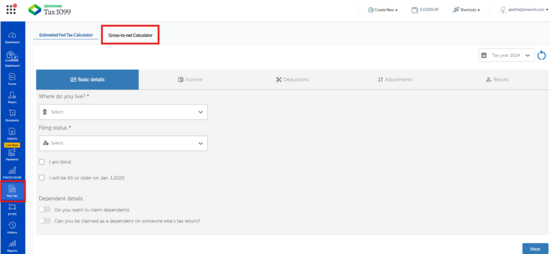
-
Select Gross-to-Net Calculator tab.The Gross-to-Net Calculator page appears.
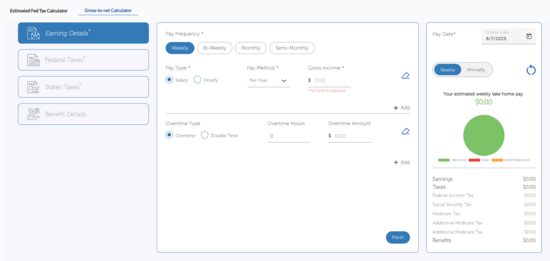
-
Select the section labelled Earning Details.
-
Under Pay Frequency.
-
Select one of the options:
-
Weekly
-
Bi-weekly
-
Monthly
-
Semi-Monthly
-
Under Pay Type, select one of the options:
-
Salary
-
Hourly
-
Under Pay Method, select one of the options:
-
Per Year
-
Per Pay Period
-
Under Gross Income, enter the gross income amount.
-
Under Overtime.
-
Select one of the options:
-
Overtime
-
Double Time
-
Under Pay Date, click on the calendar icon and select date.
-
View the summary of earnings displayed on the screen.
-
Check the breakdown of taxes displayed, which may include:
-
Federal Income Tax
-
Social Security Tax
-
Medicare Tax
-
Additional Medicare Tax
-
Ensure/Make sure all entered data is accurate and complete.
-
Click Next, the Federal Taxes page appears.
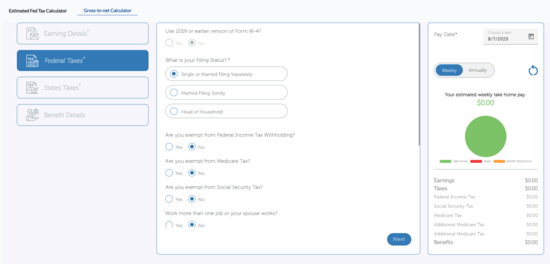
-
Under Use 2019 or earlier version of Form W-4.
-
Click the radio button next to Yes if you will be using the 2019 or earlier version.
-
Click the radio button next to No if you will not be using that version.
-
Specify Your Filing Status:
-
Click the radio button next to one of the following options:
-
Single or Married Filing Separately
-
Married Filing Jointly
-
Head of Household
-
Select Yes or No, under Are you exempt from Federal Income Tax Withholding.
-
Select Yes or No, under Are you exempt from Medicare Tax.
-
Select Yes or No, under Are you exempt from Social Security Tax.
-
Select Yes or No, under Work more than one job or your spouse works.
-
Enter the amount for dependents in Any Dependents Amount.
-
Enter the amount for other income if any exists in Any other Income Amount.
-
Enter the amount for deductions in Any Deduction Amount.
-
Enter any additional withholding amount in Any additional withholding amount.
-
Ensure that all selected options and entered amounts are accurate and complete.
-
Click Next, the State Taxes page appears.
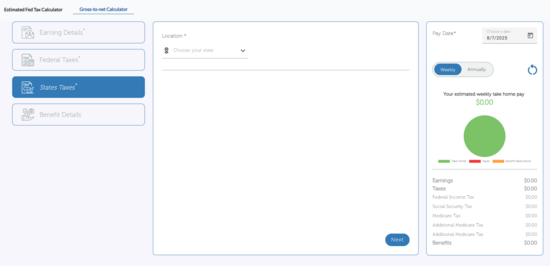
-
Select the state under Location.
-
Select the Withholding Percentage by clicking dropdown.
-
Enter the amount, in Any additional withholding amount field.
-
Under Are you exempt from State Income Tax Withholding.
-
Click the radio button next to Yes if you are exempt from state income tax withholding.
-
Click the radio button next to No if you are not exempt.
-
Ensure that all entered data, including location, withholding percentage, additional withholding amount, and exemption status, are accurate and complete.
-
Click Next, the Benefits Details page appears.
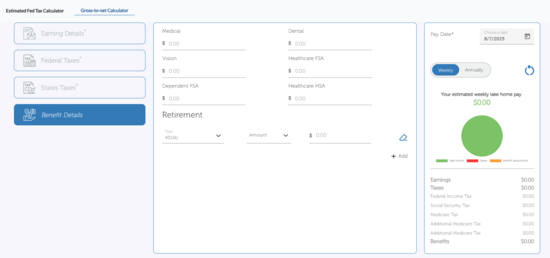
-
Enter the amount for medical expenses in Medical Expenses field.
-
Enter the amount for dental expenses in Dental Expenses field.
-
Enter the amount for vision expenses in Vision Expenses field.
-
Enter the amount for healthcare FSA in Healthcare FSA field.
-
Enter the amount for dependent FSA in Dependent FSA field.
-
Enter the amount for healthcare HAS in Healthcare FSA field.
-
Enter Retirement contributions:
-
Choose 401(k) from the dropdown menu.
-
Type the amount for retirement contributions.
-
Ensure that all entered medical expenses and retirement contributions are accurate and complete.
